湘少版英语五年级下册Unit 3 .ppt
- 格式:ppt
- 大小:696.07 KB
- 文档页数:10
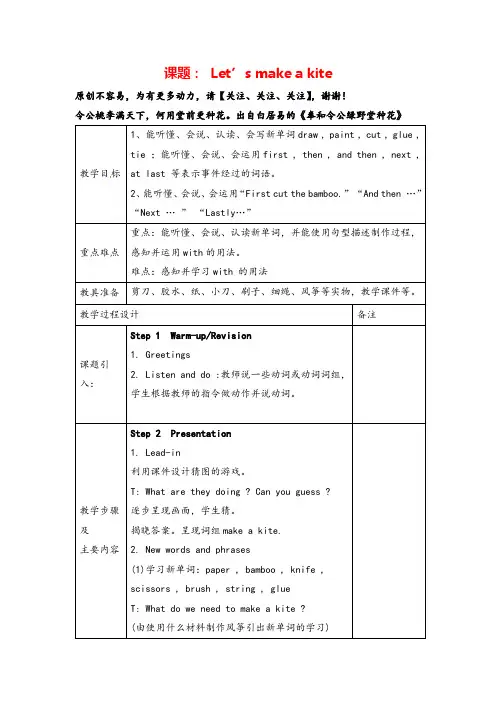
课题:Let’s make a kite原创不容易,为有更多动力,请【关注、关注、关注】,谢谢!令公桃李满天下,何用堂前更种花。
出自白居易的《奉和令公绿野堂种花》教学目标1、能听懂、会说、认读、会写新单词draw , paint , cut , glue , tie ;能听懂、会说、会运用first , then , and then , next , at last 等表示事件经过的词语。
2、能听懂、会说、会运用“First cut the bamboo.”“And then …”“Next …”“Lastly…”重点难点重点:能听懂、会说、认读新单词,并能使用句型描述制作过程,感知并运用with的用法。
难点:感知并学习with 的用法教具准备剪刀、胶水、纸、小刀、刷子、细绳、风筝等实物,教学课件等。
教学过程设计备注课题引入:Step 1 Warm-up/Revision1. Greetings2. Listen and do :教师说一些动词或动词词组,学生根据教师的指令做动作并说动词。
教学步骤及主要内容Step 2 Presentation1. Lead-in利用课件设计猜图的游戏。
T: What are they doing ? Can you guess ? 逐步呈现画面,学生猜。
揭晓答案。
呈现词组make a kite.2. New words and phrases(1)学习新单词:paper , bamboo , knife , scissors , brush , string , glueT: What do we need to make a kite ?(由使用什么材料制作风筝引出新单词的学习)()2. First , cut the bamboo .()3. Next , draw a picture and paint i witha brsh .()4. At last , fly the kite .第二步:Listen and check请学生打开书,听录音,检查答案,并尝试独立朗读。
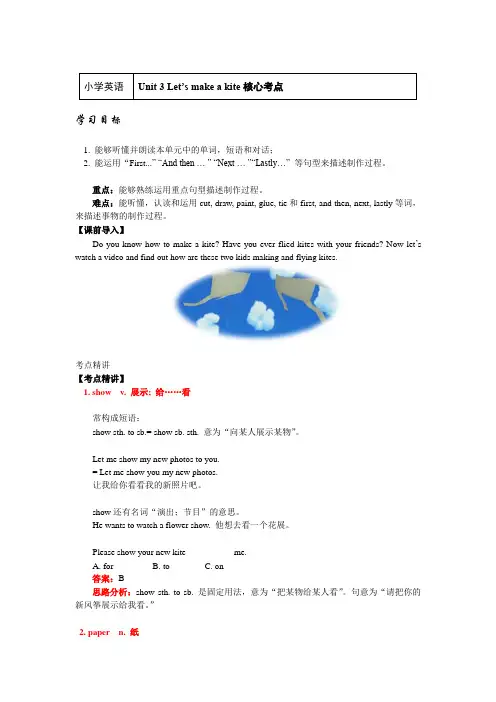
小学英语Unit 3 Let’s make a kite核心考点学习目标1. 能够听懂并朗读本单元中的单词,短语和对话;2. 能运用“First...” “And then … ” “Next … ”“Lastly…” 等句型来描述制作过程。
重点:能够熟练运用重点句型描述制作过程。
难点:能听懂,认读和运用cut, draw, paint, glue, tie和first, and then, next, lastly等词,来描述事物的制作过程。
【课前导入】Do you know how to make a kite? Have you ever flied kites with your friends? Now let’s watch a video and find out how are these two kids making and flying kites.考点精讲【考点精讲】1. show v. 展示; 给……看常构成短语:show sth. to sb.= show sb. sth. 意为“向某人展示某物”。
Let me show my new photos to you.= Let me show you my new photos.让我给你看看我的新照片吧。
show还有名词“演出;节目”的意思。
He wants to watch a flower show. 他想去看一个花展。
Please show your new kite __________ me.A. forB. toC. on答案:B思路分析:show sth. to sb. 是固定用法,意为“把某物给某人看”。
句意为“请把你的新风筝展示给我看。
”2. paper n. 纸paper作为“纸”讲,是不可数名词。
没有复数形式,其前也不能用a。
表示“一张纸”用a piece of paper,两张纸two pieces of paper.I want to borrow a piece of paper. 我想借一张纸。
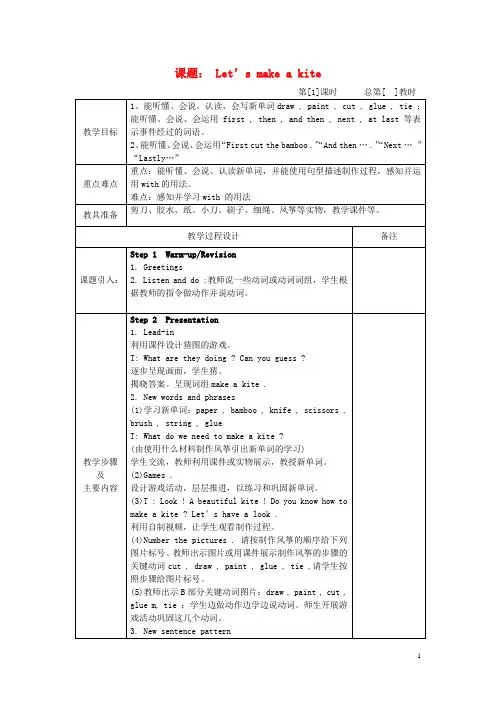
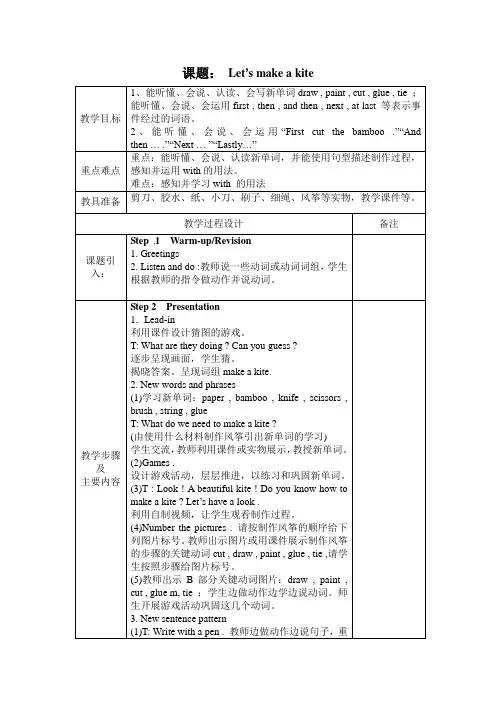
课题:Let’s make a kite教学目标1、能听懂、会说、认读、会写新单词draw , paint , cut , glue , tie ;能听懂、会说、会运用first , then , and then , next , at last 等表示事件经过的词语。
2、能听懂、会说、会运用“First cut the bamboo .”“And then ….”“Next …”“Lastly…”重点难点重点:能听懂、会说、认读新单词,并能使用句型描述制作过程,感知并运用with的用法。
难点:感知并学习with 的用法教具准备剪刀、胶水、纸、小刀、刷子、细绳、风筝等实物,教学课件等。
教学过程设计备注课题引入:Step 1 Warm-up/Revision1. Greetings2. Listen and do :教师说一些动词或动词词组,学生根据教师的指令做动作并说动词。
教学步骤及主要内容Step 2 Presentation1. Lead-in利用课件设计猜图的游戏。
T: What are they doing ? Can you guess ?逐步呈现画面,学生猜。
揭晓答案。
呈现词组make a kite.2. New words and phrases(1)学习新单词:paper , bamboo , knife , scissors , brush , string , glueT: What do we need to make a kite ?(由使用什么材料制作风筝引出新单词的学习)学生交流,教师利用课件或实物展示,教授新单词。
(2)Games .设计游戏活动,层层推进,以练习和巩固新单词。
(3)T : Look ! A beautiful kite ! Do you know how to make a kite ? Let’s have a look .利用自制视频,让学生观看制作过程。
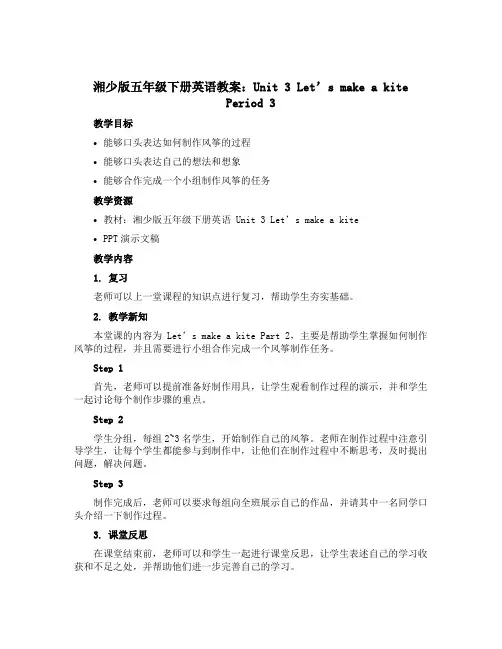
湘少版五年级下册英语教案:Unit 3 Let’s make a kitePeriod 3教学目标•能够口头表达如何制作风筝的过程•能够口头表达自己的想法和想象•能够合作完成一个小组制作风筝的任务教学资源•教材:湘少版五年级下册英语Unit 3 Let’s make a kite•PPT演示文稿教学内容1. 复习老师可以上一堂课程的知识点进行复习,帮助学生夯实基础。
2. 教学新知本堂课的内容为Let’s make a kite Part 2,主要是帮助学生掌握如何制作风筝的过程,并且需要进行小组合作完成一个风筝制作任务。
Step 1首先,老师可以提前准备好制作用具,让学生观看制作过程的演示,并和学生一起讨论每个制作步骤的重点。
Step 2学生分组,每组2~3名学生,开始制作自己的风筝。
老师在制作过程中注意引导学生,让每个学生都能参与到制作中,让他们在制作过程中不断思考,及时提出问题,解决问题。
Step 3制作完成后,老师可以要求每组向全班展示自己的作品,并请其中一名同学口头介绍一下制作过程。
3. 课堂反思在课堂结束前,老师可以和学生一起进行课堂反思,让学生表述自己的学习收获和不足之处,并帮助他们进一步完善自己的学习。
教学评价评价方式具体可以根据学生的完成情况来决定。
可以通过制作出的风筝的外观和实用性,以及小组合作的完成情况来评价学生的表现。
教师可以从学生的口头表达、制作风筝的过程中的表现、小组合作等多个方面进行评价。
教学延伸1.可以通过让学生到户外放风筝,交流自己的制作心得,来使学生进一步加强对英语知识的掌握。
2.从饮食上引出英语词汇,让学生学习用英语点菜、交流等口语表达方式,进一步提高其英语口语能力。
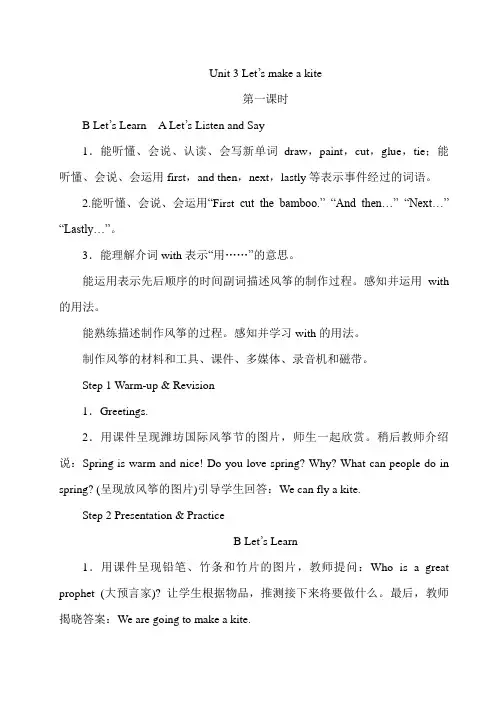
Unit 3 Let’s make a kite第一课时B Let’s Learn A Let’s Listen and Say1.能听懂、会说、认读、会写新单词draw,paint,cut,glue,tie;能听懂、会说、会运用first,and then,next,lastly等表示事件经过的词语。
2.能听懂、会说、会运用“First cut the bamboo.”“And then…”“Next…”“Lastly…”。
3.能理解介词with表示“用……”的意思。
能运用表示先后顺序的时间副词描述风筝的制作过程。
感知并运用with 的用法。
能熟练描述制作风筝的过程。
感知并学习with的用法。
制作风筝的材料和工具、课件、多媒体、录音机和磁带。
Step 1 Warm-up & Revision1.Greetings.2.用课件呈现潍坊国际风筝节的图片,师生一起欣赏。
稍后教师介绍说:Spring is warm and nice! Do you love spring? Why? What can people do in spring? (呈现放风筝的图片)引导学生回答:We can fly a kite.Step 2 Presentation & PracticeB Let’s Learn1.用课件呈现铅笔、竹条和竹片的图片,教师提问:Who is a great prophet (大预言家)? 让学生根据物品,推测接下来将要做什么。
最后,教师揭晓答案:We are going to make a kite.2.教师提问:Do you know how to make a kite? What do we need? 待学生自由发言后,教师进行补充说明,用课件呈现制作风筝所使用的材料和工具,引出单词paper,bamboo,scissors,brush,glue,string。
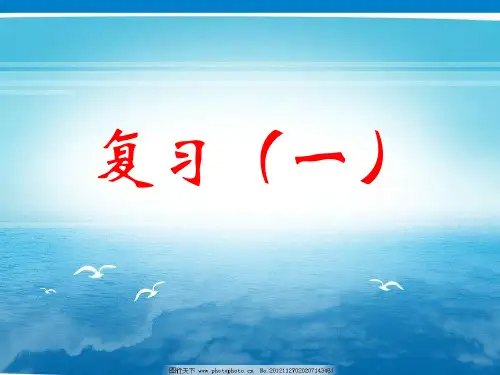
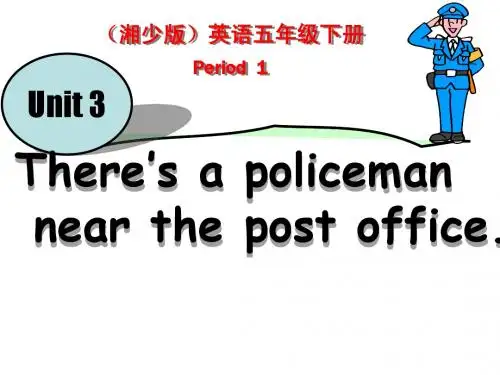
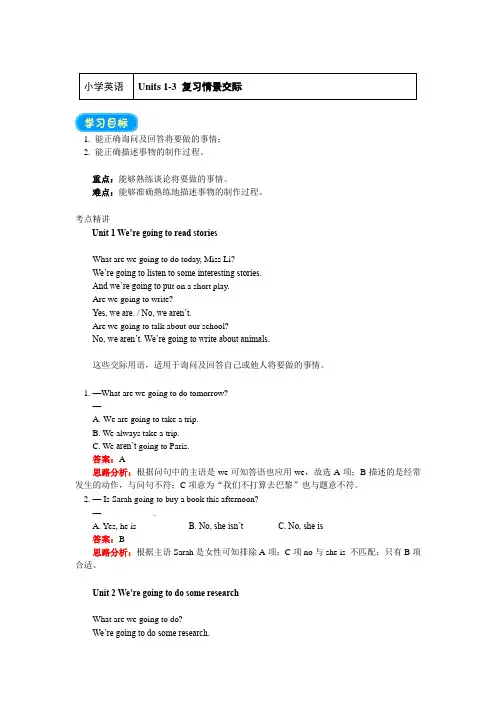
小学英语Units 1-3 复习情景交际1. 能正确询问及回答将要做的事情;2. 能正确描述事物的制作过程。
重点:能够熟练谈论将要做的事情。
难点:能够准确熟练地描述事物的制作过程。
考点精讲Unit 1 We’re going to read storiesWhat are we going to do today, Miss Li?We’re going to listen to some interesting stories.And we’re going to pu t on a short play.Are we going to write?Yes, we are. / No, we aren’t.Are we going to talk about our school?No, we aren’t. We’re going to write about animals.这些交际用语,适用于询问及回答自己或他人将要做的事情。
1. —What are we going to do tomorrow?—____________________________A. We are going to take a trip.B. We always take a trip.C. We aren’t going to Paris.答案:A思路分析:根据问句中的主语是we可知答语也应用we,故选A项;B描述的是经常发生的动作,与问句不符;C项意为“我们不打算去巴黎”也与题意不符。
2. — Is Sarah going to buy a book this afternoon?—____________.A. Yes, he isB. No, she isn’tC. No, she is答案:B思路分析:根据主语Sarah是女性可知排除A项;C项no与she is 不匹配;只有B项合适。
Unit 2 We’re going to do some researchWhat are we going to do?We’re going to do some research.We’re going to read and find information.What are they going to do?They’re going to study and think.They’re going to collect pictures.What is Mary going to do?She is going to write a report.What is your group going to do?My group is going to do some research.这些交际用语适用于询问和回答自己和他人将要从事的活动。
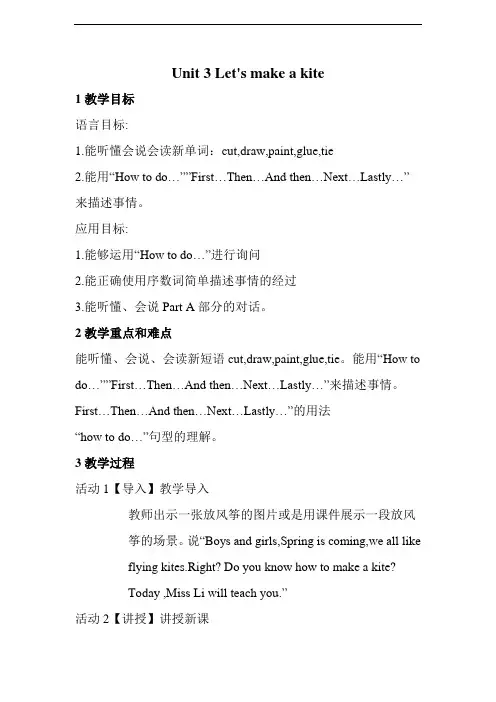
Unit 3 Let's make a kite1教学目标语言目标:1.能听懂会说会读新单词:cut,draw,paint,glue,tie2.能用“How to do…””First…Then…And then…Next…Lastly…”来描述事情。
应用目标:1.能够运用“How to do…”进行询问2.能正确使用序数词简单描述事情的经过3.能听懂、会说Part A部分的对话。
2教学重点和难点能听懂、会说、会读新短语cut,draw,paint,glue,tie。
能用“How t o do…””First…Then…And then…Next…Lastly…”来描述事情。
First…Then…And then…Next…Lastly…”的用法“how to do…”句型的理解。
3教学过程活动1【导入】教学导入教师出示一张放风筝的图片或是用课件展示一段放风筝的场景。
说“Boys and girls,Spring is coming,we all likeflying kites.Right? Do you know how to make a kite?Today ,Miss Li will teach you.”活动2【讲授】讲授新课1.Check the word preparation.(1)Ask Ss to listen to the tape or teacher and repeat the words together. Then read one by one. Others correct the pronunciation mistakes.(2)Discuss the problems.(3) Competition: 游戏:听音,补全单词(教师念出一个单词的部分读音,请学生迅速说出全部读音)2. Learn the new sentences.(1) Present the new drills:“Howto …”“First…Then…And then…Next…Lastly…”造句。
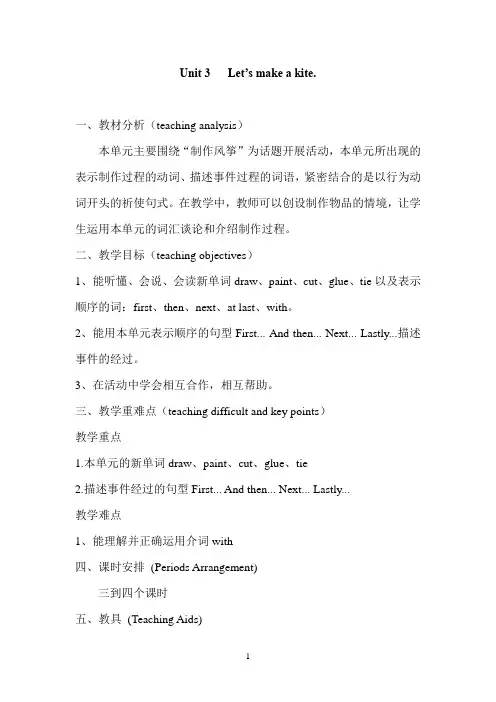
Unit 3 Let’s make a kite.一、教材分析(teaching analysis)本单元主要围绕“制作风筝”为话题开展活动,本单元所出现的表示制作过程的动词、描述事件过程的词语,紧密结合的是以行为动词开头的祈使句式。
在教学中,教师可以创设制作物品的情境,让学生运用本单元的词汇谈论和介绍制作过程。
二、教学目标(teaching objectives)1、能听懂、会说、会读新单词draw、paint、cut、glue、tie以及表示顺序的词:first、then、next、at last、with。
2、能用本单元表示顺序的句型First... And then... Next... Lastly...描述事件的经过。
3、在活动中学会相互合作,相互帮助。
三、教学重难点(teaching difficult and key points)教学重点1.本单元的新单词draw、paint、cut、glue、tie2.描述事件经过的句型First... And then... Next... Lastly...教学难点1、能理解并正确运用介词with四、课时安排(Periods Arrangement)三到四个课时五、教具(Teaching Aids)录音机、图片、卡片、CD、课件等等。
Period 1Step 1Warm-up1.Greetings.2.Listen and do:The teacher say some verbs or verbal phrases and Ss do as the teacher said.Step 2 Presentation1.Lead-inPresent a picture of making a kite on the big screen and have the Ss guess.T: What are they doing? Can you guess?Then as they get the right answer, present the phrase “make a kite” on the big screen.2.New words and phrases(1)learn the new words: paper, bamboo, knife, scissors, brush, string, glue T: What do we need to make a kite?(Present the new words by asking them about the necessary material to make a kite.)Show them the corresponding pictures on the screen and teach the new words.(2)Games.Practice the new words through the game loud and low voice.(3)T: Look! A beautiful kite! Do you know how to make a kite? Let’s have a look!Show Ss the process of making a kite in the form of a video.(4)Number the pictures.Number the pictures according to the steps of making a kite.(5)the teacher present pictures of the key verbs in part B : draw, paint, cut, glue,tie. And Ss should do the actions and say out the verbs at the same time.3.New sentence patterns.(1)T: Write with a pen.By doing the reciprocal actions, the teacher help Ss to understand the meaning of the preposition “with”. Then say out more sentences in the same pattern.(2)present the sentence on the PPT and have Ss try to say the sentences by themselves.Cut the bamboo with a knife.Cut the paper with scissors.Paint the paper with a brush.(3)using the sentence cards to play a game to consolidate the sentences.4.Dialogue(1)Look, listen and cross.(2)Listen and check.(3)Listen and repeat.(4)Read by themselves.Step 3 Practice1.Match the sentences with the pictures. Then try to say out the process of making a kite.2.Mute the CD and have Ss to dub the dialogue.Step 4 Act and play.Offer the Ss some context to let them make a conversation.Step 5 homework1.Listen to the tape and repeat.2.Write the process of making a kite on the notebook.Period 2Step 1 warm-up1.Greetings .2.Show Ss the word cards very quickly and have them to read the words: draw, paint, cut, glue, tie.step 2 Practice1.Make sentences with the verbs.Divide the whole class into several groups and have a sentence-making competition.2.Homework show.3.Open the textbook and watch the VCD of part C to learn to draw a picture. Then repeat after the tape.4.Give them the key words and have Ss to describe the process of draw a picture.Step 3 Pre-reading1.Ask and answer between the teacher and Ss.T: What can you see?S1: I can see a ... . What can you see?S2: I can see a ... . What can you see?S3: ...2.Show Ss part of the picture in part D and use the sentence “I can see ...” to describe the picture.Step 4 While-reading1.Go through the text very fast and make some judgments according to the picture.2.Read the text again and underline the key words of drawing the picture.3.Listen to the tape and repeat after it.Step 5 Post-reading1.Reiterate the process.Step 6 homework1.Read the text in part D for 2 to 3 timesPeriod 3Step 1 Revision1.Greetings2.Games:(1)Quick responseT: Touch you nose/ear/mouth/...(2)Guessing gameT:I can see a word beginning with the letter “W”. Can you guess?3.Make sentences with the word “with”4.Free talkT: What can you do with a pen?5.Homework showStep 2 Practice1.The teacher present the process of drawing a doll with colour and explain the steps and tricks.2.Ss finish the reading and writing exercise in part E.Step 3 Consolidation1.present the 5 pictures in part F and let Ss number the pictures.2.Discuss in groups and illustrate the process of making a kite.(using the words first, then, and then, next, at last etc.)3.The teacher write the questions on the blackboard and Ss answer. What does Peter cut the bamboo with?What does Peter draw his kite with?What does Peter cut the paper with? What does Peter paint on the paper with?What does Peter paste the paper with? Step 5 homework1.Finish the exercise in unit 3。
(湘少版)五年级英语下册《Unit 3 Period 3》说课稿1.背景本文档主要介绍湘少版五年级英语下册的《Unit 3 Period 3》的课程内容和教学目标,以及适用的教学方法和技巧,帮助老师们更好地准备和教授这个课程。
2. 教学目标1.能够听懂并理解短对话中的关键词汇和句子,包括名字、年龄、爱好、职业等。
2.能够运用所学的词汇和语法,描述自己的爱好、年龄、职业等。
3.能够熟练朗读课文中的短对话和单词,并模仿语音、语调和语音语调。
3. 教学内容本节课主要围绕“Occupations”这个主题进行教学,包括以下内容:1.在课文中学习有关不同职业的单词和词组,并熟悉它们的用法。
2.学习短对话,理解其意义,并运用相关词汇和语法进行表述。
3.练习熟练朗读短对话和单词,并模仿语音、语调和语音语调。
4.教学方法和技巧1.听力练习,通过听短对话,理解对话中出现的关键词汇和句子,并通过课堂练习进行巩固。
2.通过口语练习,加深学生对不同职业的认识和理解,并提高他们的说英语的自信心。
3.课堂互动,让学生充分参与课堂活动,鼓励他们主动提问和回答问题。
5.教学步骤步骤一:热身1.带上学生回顾上一节课的内容,以及检查所学习的单词和句子。
这有助于巩固他们的记忆和复习。
2.听写单词,检查学生掌握程度。
步骤二:教学细节1.老师播放课文录音,在学生集中注意听。
2.教师对短语进行解释和细讲,帮助孩子理解和学习。
3.提供练习,鼓励学生运用所学的词汇和语法进行口语练习。
4.通过课堂练习和课外练习,加深学生对所学材料的理解与掌握。
步骤三:总结教师回顾本课学习的内容和知识点,强调学生所学的重点,并总结本课的教学效果。
同时预告下一次课程的主题,以激发同学们的学习兴趣和动力。
6.评估和反思评估是教学工作的重要组成部分,能够帮助学校制定更加精细教学计划和收获教学的效果。
1.通过课堂练习采购小测验的方式,检查学生对重点知识点的掌握情况。
2.根据解释、总结、总结等环节的反应,了解学生对所学内容的掌握程度。
Unit3 单元总览一、教学目标二、单元分析1. 学习链接(1) 词汇①make a kite, brush, paint, glue(名词,胶水)在五年级上册第4单元C、D部分出现过,但不要求掌握。
②first, then等描述事件经过的词语在五年级下册第1单元D部分出现过,为本单元的学习打下一定的基础。
(2) 句型以行为动词原形开头的祈使句的肯定句式,在以前的学习中有所了解,如:“Sit down.” “Stand up”在本单元只需要接触祈使句式即可,不需要刻意地强调。
(3) 语法介词with表本“和一起”的含义,学生已经接触过,如:“Lingling has dinner with her mother and father.”在本单元学习介词with表“用”的意思,学生需要理解with的这一用法。
2. 话题解读本单元主要围绕“制作风筝”为话题开展活动,本单元所出现的表示制作过程中的动词、描述事件过程的词语,紧密结合的是以行为动词原形开头的祈使句的肯定句式。
在教学中教师可以创设制作物品的情境,设计制作风筝、布娃娃等的情境,画出或描写制作过程等方式,让学生运用本单元的词汇和句型来谈论和介绍制作过程。
3. 难点分析本单元难点为介词with的用法,要求学生能理解并正确使用介词with。
介词with 本身有多种用法,对学生而言有难度。
关于本难点教师只需要求学生熟悉、掌握句型,在句型中去体会、感知With作为“用”的意义的用法即可,在以后的学习中学生还将进一步学习。
三、课时安排四、本单元知识拓展各国风筝的特点及风俗虽然对于风筝的起源有不同的看法,但是大多数人还是认为风筝的起源在中国,大约在8世纪时传播到世界各国。
一般而言,由于亚洲地区盛产的竹材适合各种自由曲线的结构设计,并且风筝的样式可以与神话传说相结合,所以风筝造型千变万化且富有个人色彩;而西方国家因为缺少竹材而以玻纤或碳纤为材料,在风筝造型及色彩上力求鲜明、简洁,多以单纯的色块来表现。